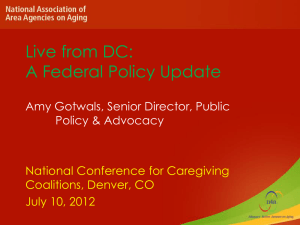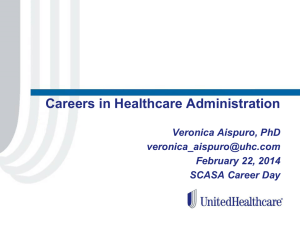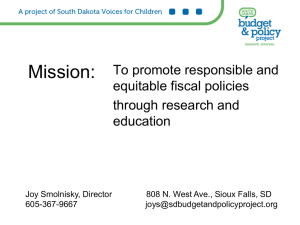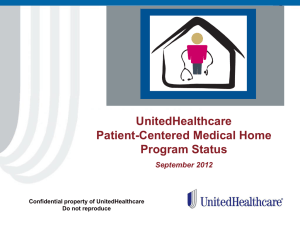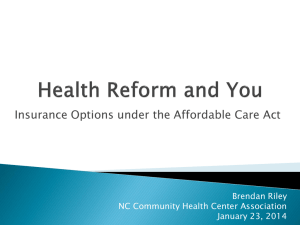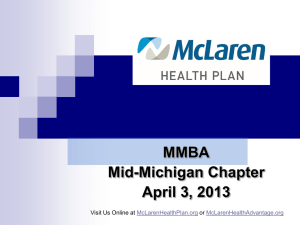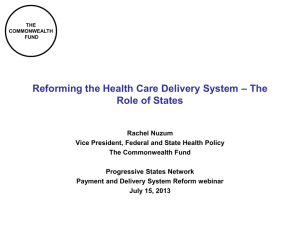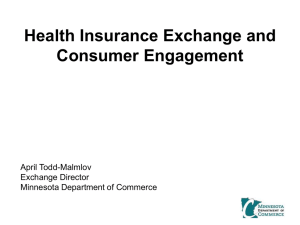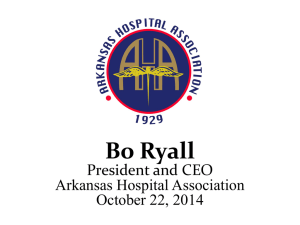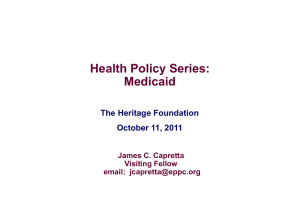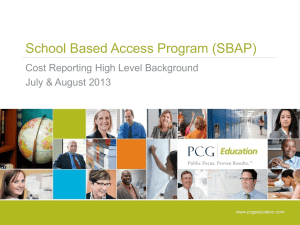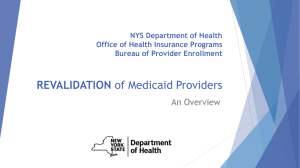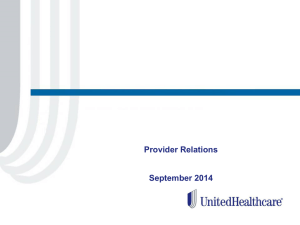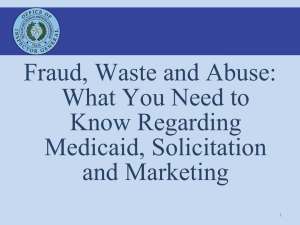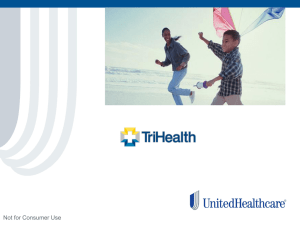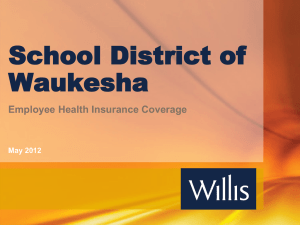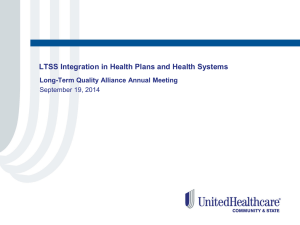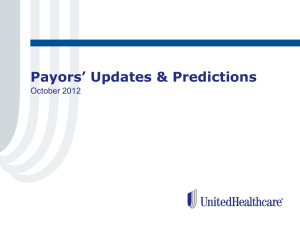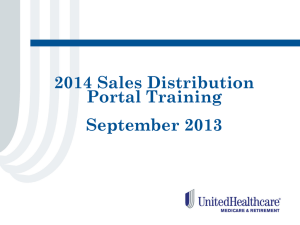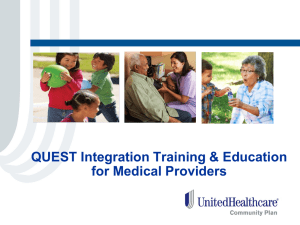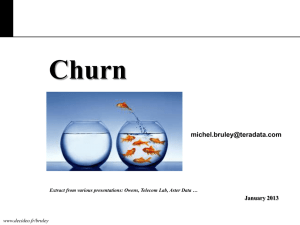BASIC UHC PowerPoint Template - National Governors Association
advertisement
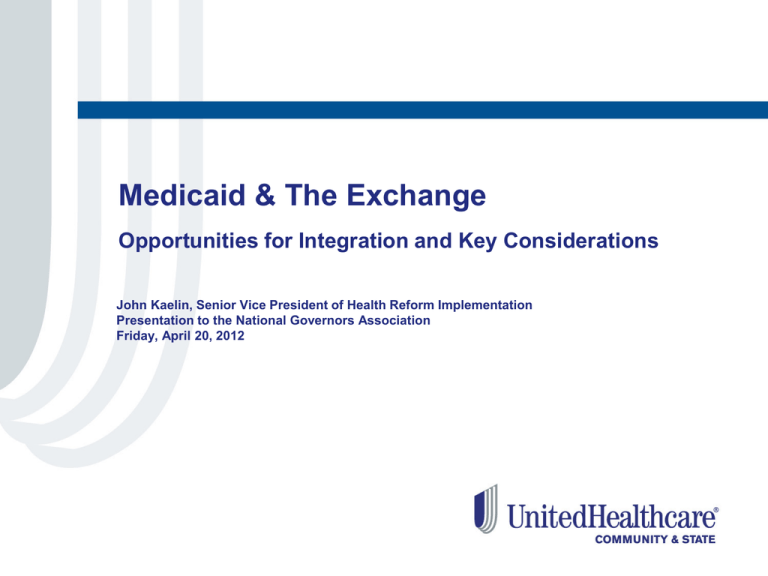
Medicaid & The Exchange Opportunities for Integration and Key Considerations John Kaelin, Senior Vice President of Health Reform Implementation Presentation to the National Governors Association Friday, April 20, 2012 UnitedHealthcare’s Health Benefits Platform Individuals Served: 25M people Individuals Served: 9M people Individuals Served: 3.7M people Serves employers ranging from sole proprietorships to large, multi-site and national employers, students and individuals Operates the largest business in America dedicated to the health and well-being of individuals over age 50 Manages health care services for state Medicaid and other publicly funded programs and their beneficiaries 2 Confidential Property of UnitedHealth Group. Do not distribute or reproduce without express permission of UnitedHealth Group. Expansion Projections: 2019 View >$43,560 Non-subsidized coverage $43,560 ~15,000,000 individuals $32,670 Premium subsidies available to families with incomes between 133-400% FPL (to purchase insurance through the Exchanges) $21,780 ~8,000,000 individuals $14,484 ~16,000,000 individuals Current Medicaid States have the option to create a Basic Health Plan for uninsured individuals with incomes between 133-200% FPL who would otherwise be eligible to receive premium subsidies in the Exchange. Medicaid Expansion: Uniform 133% FPL and new definition (Modified Adjusted Gross Income, or MAGI) Note: This visual is scaled to 2011 FPL guidelines for a household size of 1. Numbers do not necessarily reflect all net new coverage. Sourced from CBO estimates, available at: http://www.cbo.gov/budget/factsheets/2011b/HealthInsuranceProvisions.pdf 3 Medicaid Expansion: Anticipated Characteristics • Many researchers have studied the anticipated characteristics of individuals who will receive coverage through the Medicaid Expansion in 2014. • Results of these studies vary widely. • Some predict a higher cost population with a significant need for services to treat multiple chronic conditions, behavioral health, and substance abuse. • Others predict a lower cost population that is relatively healthy, predominately young (between the ages of 19 – 34), and who predominantly reports themselves to be in “excellent or very good” physical and mental health. • In reality, we are likely to see a blend of these characteristics, but should not expect this population to be homogenous. • Numerous factors may influence the characteristics of the Expansion population in each market, including state outreach efforts, state sales and marketing requirements, and the extent to which a state already covers a portion of this population. 4 Relatively High Need Relatively Low Need • Less likely to be parents • Disproportionately “young” • Relatively high need (behavioral health, substance abuse, multiple chronic conditions) • Individuals at the lower end of the poverty scale incur disproportionately high costs • More likely to be in a working household • Less likely to be parents • Relatively healthy Center for Health Care Strategies (CHCS) Findings • In 2010, UnitedHealthcare participated in a project with CHCS and select states to understand the needs of the Medicaid Expansion population. • In contrast to the CBPP study, which relied on survey data, this study drew heavily from utilization and costs experiences in several states. • While highlights are provided on the next slides, the full report is available at: http://www.chcs.org/usr_doc/Medicaid_Expansion_Brief.pdf 5 Summary of CHCS Findings • Specific programs and results vary from state to state, but the overall findings are consistent: AZ On average, childless adults cost more per year than the TANF population On average, individuals at the lower end of the poverty scale incur disproportionately high costs Childless adults tend to be associated with high utilization (particularly for services related to chronic conditions, mental health, and substance abuse) 6 IN ME NY OR PA Implications of Churn • Individuals with fluctuating income will move between Medicaid and Exchange eligibility. • Key aspects of coverage, such as benefits, provider network, and out of pocket costs, may be disruptive and confusing. • Individuals experiencing such shifts may require additional support and assistance as they navigate the effects of coverage changes. Income of $15,246 per year (140% FPL in 2011 dollars) Income of $14,702 per year (135% FPL in 2011 dollars) Medicaid Benefits Medicaid Network Care Management (If MCO) No Premium No Cost Share Essential Benefits Commercial Network (likely restricted) * This diagram assumes that Medicaid covers up to 138% FPL and assumes no Basic Health Plan 7 Confidential Property of UnitedHealth Group. Do not distribute or reproduce without express permission of UnitedHealth Group. Different Care Management (or potentially no care management) Significant (yet subsidized) Premium Copays, Coinsurance Its Impact On Consumers Absent strategies to address churn, frequent shifts between programs will cause confusion, disruption and continuity of care issues (access, benefits, services). • Can I still go to my doctor or health care professional? • Which ID card should I use? • Who do I call? • Which program are my children in? How can our family stay together? • Why isn’t this benefit covered any more? • I still don’t have a car and need a ride to my doctor! • I don’t speak English, can a translator help me? • Can I stay with my same health plan? • What do you mean I have to pay for care (a new copay/premium for someone moving from Medicaid to the Exchange?) 8 Confidential Property of UnitedHealth Group. Do not distribute or reproduce without express permission of UnitedHealth Group. And Then There Is The “Cliff” Though Exchange consumers at lower income levels will receive substantial premium subsidies, their cost to purchase coverage will be significant. Premiums, copayments, deductibles…the terminology may lead to confusion for Medicaid consumers who move to the Exchange. The cost obligations may be overwhelming and lead them not to purchase coverage. Annual Income %FPL (Family Size 1) Eligibility Premium (after subsidy) Expected Cost Sharing Total Out of Pocket $14,702 135% Medicaid $0 $0 $0 $15,246 140% Exchange $518 $343 $861 Consumers will enter and have their eligibility determined via the Exchange. A modest change in income, in this example and increase of $544 pre-tax dollars annually, can lead to a substantial increase in an individuals cost obligation (in this case $861 annually in after-tax dollars). 9 Confidential Property of UnitedHealth Group. Do not distribute or reproduce without express permission of UnitedHealth Group. Potential Levers to Address “Churn” Potential Levers and Requirements Policy End to End Eligibility, Recertification and Enrollment Via Exchange Align the Benchmark and Essential Health Benefits The Basic Health Plan Common Health Plans across Medicaid, The Exchange, and BHP Common Providers across Medicaid, The Exchange and BHP A Focus on Affordability, the Right Price Points Special Enrollment Rules For Health Plans that Operate In Medicaid & The Exchange Same Member ID Card For All Programs Pro-Actively Track and Conduct Outreach to Help Families In Transition, including Health Insurance Literacy Consistent Enrollment Rules, Timeframes, and Definitions for Medicaid and the Exchange 10 Confidential Property of UnitedHealth Group. Do not distribute or reproduce without express permission of UnitedHealth Group. Product Tool Contact Information John Kaelin Senior Vice President, Health Reform Implementation John_kaelin@uhc.com 11 Confidential Property of UnitedHealth Group. Do not distribute or reproduce without express permission of UnitedHealth Group.

